
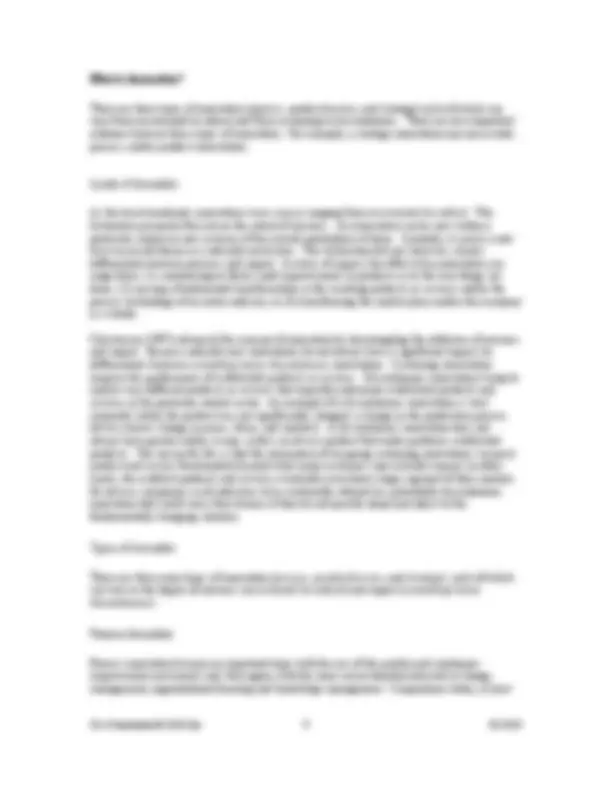
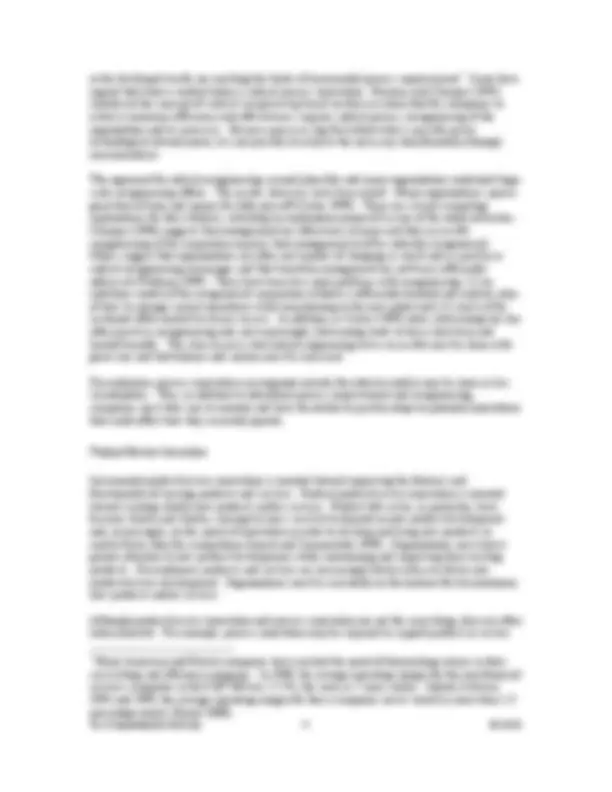
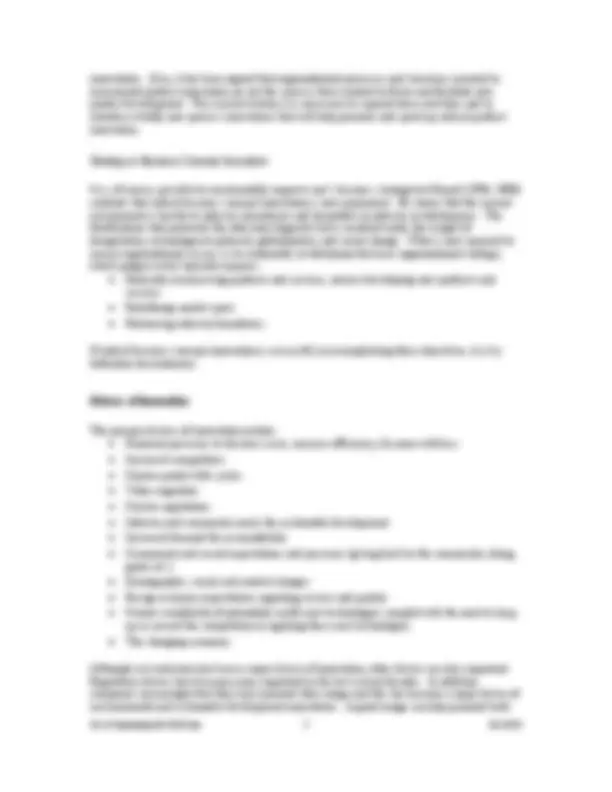

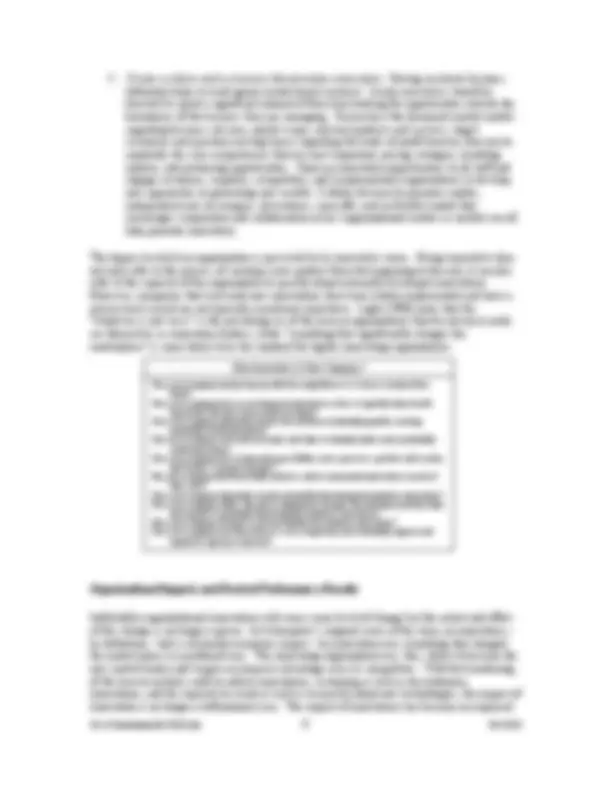
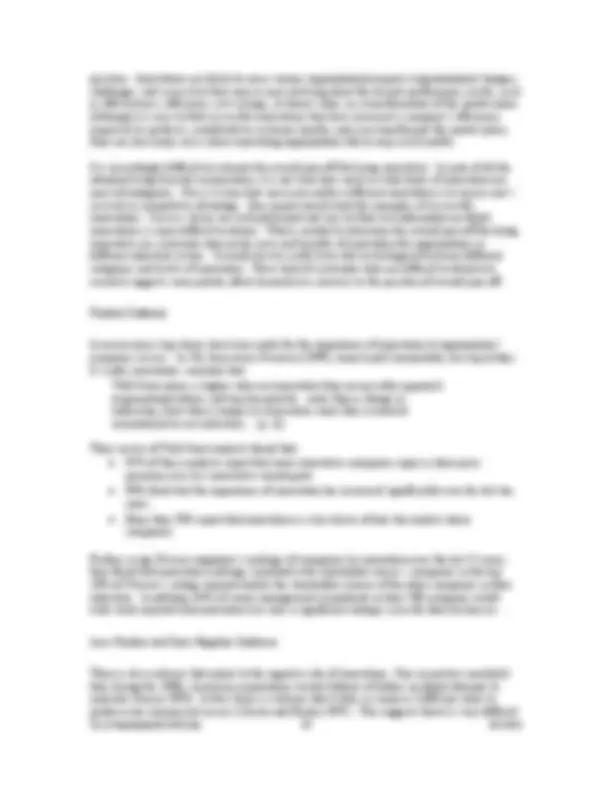
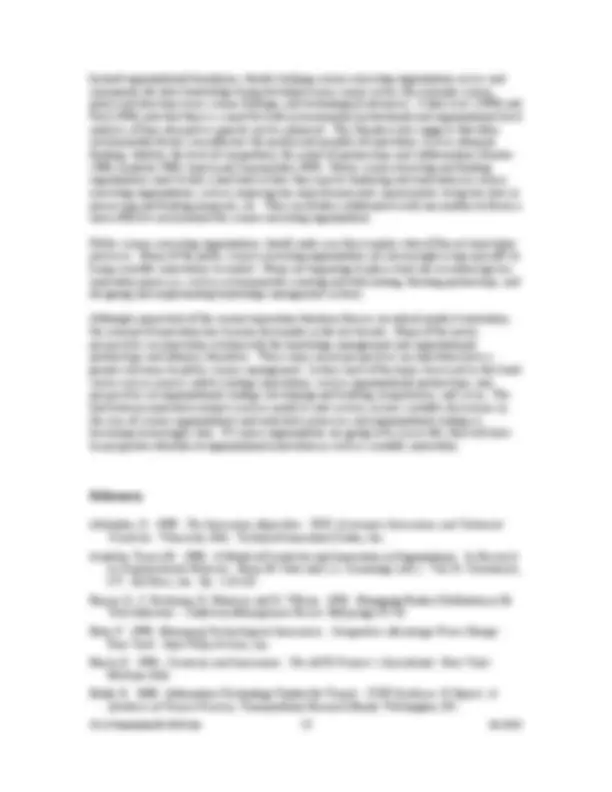
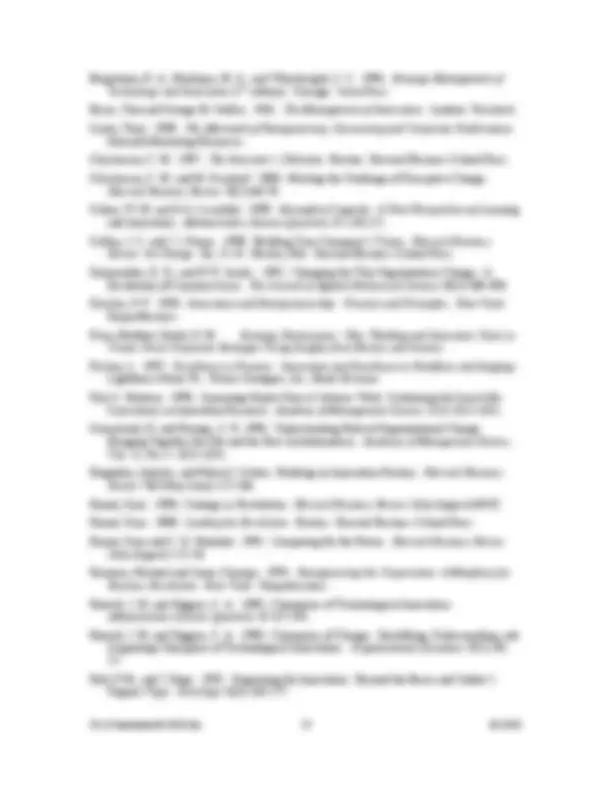
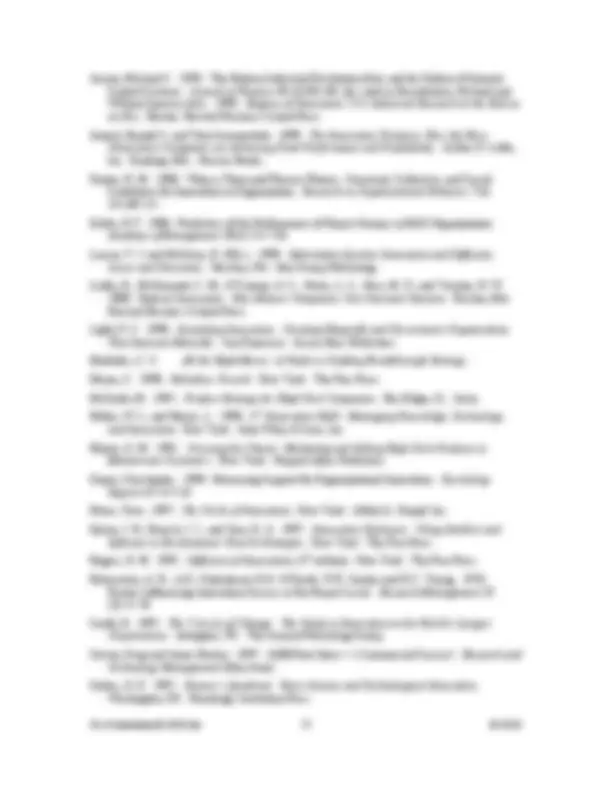


Study with the several resources on Docsity

Earn points by helping other students or get them with a premium plan


Prepare for your exams
Study with the several resources on Docsity

Earn points to download
Earn points by helping other students or get them with a premium plan
Community
Ask the community for help and clear up your study doubts
Discover the best universities in your country according to Docsity users
Free resources
Download our free guides on studying techniques, anxiety management strategies, and thesis advice from Docsity tutors
Management Benchmark Study-Book Summary Chapter 14-Literature-Elizabeth L. Malone Innovation, Kathryn A. Baker, Organizational Innovation, Levels of Innovation, Product/Service Innovation, Drivers of Innovation
Typology: Summaries
1 / 16

This page cannot be seen from the preview
Don't miss anything!










If defined broadly, innovation can be seen as the business of science organizations. However, like most of the organizational literature, the innovation literature has largely focused on innovation in private sector business organizations. This literature may, nonetheless, have insights that can be used by the science organizations, both private and public. First, although science organizations need to innovate, they have not necessarily taken the lead in systematically studying how organizational and environmental factors can best promote innovation. Also science organizations in both the private and public sector are under greater pressure not only to generate innovative science but also to function as a business. For example, there is greater emphasis on commercializing scientific discoveries, having a solid and well-designed portfolio of science programs and projects that help the organization adapt to external changes in funding priorities, and demonstrating results and favorable cost/benefit ratios. This innovation literature may provide insights into balancing innovation with business realities. While the literature on innovation in private sector organizations may be a source of useful insights, it may also be the case that studying science organizations could provide critical insights into how to promote and sustain innovation in private sector business organizations. Public science organizations should consider playing a lead role in promoting strategies for encouraging and sustaining innovation and developing a true innovation competency.
The literature on innovation has a long history. The early research on innovation tended to address the organization’s ability to respond and adapt to external and/or internal changes (Burns and Stalker 1961; Hull and Hage 1982). Subsequent work on innovation stressed more pro-active innovation and distinguished between types of innovation. Emphasis was on the organization’s ability to promote both process and product innovation, regardless of an immediate need for change (Kanter 1988). The organization’s ability to promote process and product innovation has been argued to be no longer sufficient and a third type of innovation has been introduced in the literature—called strategy innovation by some and business concept innovation by others. This type of innovation stresses the growing need for today’s organizations to proactively address challenges of the future by undertaking radical innovation that will transform their environments and the marketplace (Hamel and Prahalad 1994; Hamel 1996). Organizations can no longer remain successful by merely adapting to external change and/or innovating in terms of products/services.
The concept of innovation has become more complicated in other ways as well. The first major scholar to address this topic, Joseph Schumpeter, defined innovation as encompassing the entire process, starting from a kernel of an idea continuing through all the steps to reach a marketable product that changes the economy. Now, there is not only a distinction between three major types of innovation (process; product/service; and business concept) but current scholars now distinguish levels of innovation (incremental to radical and sustaining versus discontinuous), no
(^1) Related chapters include: Strategy; Change Management; Competencies; Organizational
Alliances, Partnerships and Networks; Creativity.
longer restricting the term to major innovations that change the economy. Finally innovation is no longer restricted to the process of creating something new from beginning to end but can include the capacity to quickly adopt externally created innovations that may be of benefit to the organization.
Figure 1 provides a general framework for understanding organizational innovation.
Organizational Impacts
This framework identifies the following major questions considered by those interested in organizational innovation:
♦ What is innovation? ♦ What are the drivers of innovation? ♦ What can enable or hinder innovation? ♦ What are the results of innovation—the organizational impacts as well as the desired and actual performance results?
in the developed world, are reaching the limits of incremental process improvement.^2 Some have argued that what is needed today is radical process innovation. Hammer and Champy (1994) introduced the concept of radical reengineering based on their assertion that for companies to achieve maximum efficiency and effectiveness requires radical process reengineering of the organization and its processes. Because processes lag far behind what is possible given technological advancement, it is not possible to achieve the necessary transformation through incrementalism.
The argument for radical reengineering seemed plausible and many organizations undertook large scale reengineering efforts. The results, however, have been mixed. Many organizations spent a great deal of time and money for little pay-off (Carter 1999). There are several competing explanations for these failures, including an explanation proposed by one of the initial advocates. Champy (1996) suggests that management has often been a barrier and that successful reengineering of the corporation requires that management itself be radically reengineered. Others suggest that organizations are often not capable of changing as much and as quickly as radical reengineering encourages and that transition management has not been sufficiently addressed (Feldman 1999). There have been two main problems with reenginereing: (1) an ambitious model of the reengineered corporation without a sufficiently detailed and realistic plan of how to manage current operations while transitioning to the new model and (2) a lack of the sustained effort needed to ensure success. In addition, as Carter (1999) notes, downsizing has too often posed as reengineering and, not surprisingly, downsizing tends to have short-term and limited benefits. The clear lesson is that radical engineering to be successful must be done with great care and that balance and caution must be exercised.
Discontinuous process innovation can originate outside the industry and/or may be more or less serendipitous. Thus, in addition to intentional process improvement and reengineering, companies must take care to monitor and have the ability to quickly adapt to potential innovations that could affect how they currently operate.
Incremental product/service innovation is oriented toward improving the features and functionality of existing products and services. Radical product/service innovation is oriented toward creating wholly new products and/or services. Product life cycles, in particular, have become shorter and shorter, causing business survival to depend on new product development and, increasingly, on the speed of innovation in order to develop and bring new products to market faster than the competition (Jonash and Sommerlatte 1999). Organizations must direct greater attention to new product development, while maintaining and improving their existing products. Discontinuous products and services are increasingly likely with ever-faster new product/service development. Organizations must be constantly on the lookout for discontinuous new products and/or services.
Although product/service innovation and process innovation are not the same thing, they are often interconnected. For example, process innovation may be required to support product or service
(^2) Many American and British companies have reached the point of diminishing returns in their
cost-cutting and efficiency programs. In 1999, the average operating margin for the non-financial services companies in the S&P 500 was 15.7%, the same as 5 years earlier. Indeed, between 1994 and 1999, the average operating margin for these companies never varied by more than 1. percentage points (Hamel 2000).
innovations. Also, it has been argued that organizational processes and structures oriented to incremental product innovation are not the same as those needed to foster and facilitate new product development. The current wisdom it is necessary to separate these activities and to introduce wholly new process innovations that will help promote and speed-up radical product innovation.
It is, of course, possible to incrementally improve one’s business strategy but Hamel (1996, 2000) contends that radical business concept innovation is now paramount. He claims that the current environment is hostile to industry incumbents and hospitable to industry revolutionaries. The fortifications that protected the industrial oligarchy have crumbled under the weight of deregulation, technological upheaval, globalization, and social change. What is now required to ensure organizational success is to continually revolutionize the basic organizational strategy, which progressively typically requires: ♦ Radically reconceiving products and services, not just developing new products and services ♦ Redefining market space ♦ Redrawing industry boundaries.
If radical business concept innovation is successful in accomplishing these objectives, it is by definition discontinuous.
The primary drivers of innovation include: ♦ Financial pressures to decrease costs, increase efficiency, do more with less ♦ Increased competition ♦ Shorter product life cycles ♦ Value migration ♦ Stricter regulations ♦ Industry and community needs for sustainable development ♦ Increased demand for accountability ♦ Community and social expectations and pressures (giving back to the community, doing good, etc.) ♦ Demographic, social, and market changes ♦ Rising customer expectations regarding service and quality ♦ Greater availability of potentially useful new technologies coupled with the need to keep up or exceed the competition in applying these new technologies ♦ The changing economy.
Although cost reduction has been a major driver of innovation, other drivers are also important. Regulatory drivers have become more important in the last several decades. In addition, companies increasingly feel they must promote their image and this has become a major driver of environmental and sustainable development innovations. A good image can help promote both
large organizations have attempted to foster intrapreneurships within the company but, increasingly, large organizations are creating small entrepreneurial spin-offs to enhance their capacity to innovate. Hamel (2000) offers suggestions for larger firms to become incubators of innovation (internally, externally, and via appropriation) and sees no inherent contradiction in being both a large and an innovating organization (see Chapter 4, “Change Management” for additional discussion of these challenges).
The Individual Level : Factors to look for at the individual level include: employee empowerment and engagement, trust, training, job rotation, and the extent and range of individual networks. The Project Level : Factors to look for at the project level include: a diverse mix of project team members, conversation rules and management, and an initial openness to new ideas and withholding of criticism to a later point in the process. As the speed of innovation is becoming a greater concern, greater attention is being focused on ways to speed up innovation projects. There has also been greater attention directed at differentiating between two critical phases of innovation projects: the fuzzy front-end or Phase I activities and Phase II activities. Phase I activities involve new product conceptualization, analysis, and definition, and currently account for half the new product development cycle time. Phase II activities involve the more typical activities of product design, piloting, production, and early marketing. Some have argued that Phase I activities need to be dealt with separately as they require a different type of project management approach (Bacon et al. 1994). The Organizational Level : Organizations must have effective, efficient, and speedy systems and processes for the following: ♦ Environmental scanning, identifying discontinuities, surveying customer needs, encouraging new ideas to be advanced by staff members, and innovation activist and other forms of training. ♦ Other means of promoting knowledge absorption and sharing, such as the ability to communicate across organizational boundaries, communities of practice, enterprise level knowledge systems, and problem identification and problem solving processes. ♦ Deconstructing the dominant mental models regarding business mission, market scope, relevant products and services, target customers and questioning existing biases regarding the kinds of profit boosters that can be exploited, the core competencies that are most important, pricing strategies, bundling options, and partnering opportunities. ♦ Sustained, innovative strategizing and strategy implementation. ♦ On-going classification, screening, and prioritization of new ideas. ♦ Managing the innovation stream—the number of ideas being pursued at a given time and their developmental stages. ♦ Effective innovation project management. ♦ Effective innovation utilization, transfer, diffusion—the culmination of innovation is to transfer the innovation to those who will exploit it through successful commercialization and, as needed, promoting its adoption into organizational practice and/or individual life styles. ♦ Effective change management. ♦ Promoting a broad definition of business boundaries, fluid organizational boundaries, and a wide and open market for ideas/talent. ♦ Motivating, rewarding, and recognizing innovation. This sounds very similar to knowledge management, particularly as the focus has expanded beyond increasing the speed of innovation outputs and recognizes the importance of identifying and capturing new ideas/knowledge. Also, it has been found that smaller and less hierarchical organizations are more capable of innovation. Some large organizations have attempted to foster internal intrapreneurships but, increasingly, they are creating small entrepreneurial spin-offs to enhance their capacity to innovate. The Environmental Level : Factors at the environmental are now getting greater attention. These include: the level of competition and extent of customer options, geographical co-location, inter-organizational associations and communities of practice, partnerships and alliances, the regulatory context, and the extent of customer and stakeholder engagement.
The external environmental context is now receiving greater attention. Previously, the external environment had been considered a given – beyond the control of the organization. However, inter-organizational collaborations have now become a major topic in the innovation literature. The ways organizations can take advantage of the environment to encourage and sustain innovation and they ways they can use innovation to buffer themselves from environmental threats are areas that need to be further developed. The literature on institutionalism can provide a possible basis for linking organizational context and environmental (inter-organizational) context and demonstrating how these factors jointly affect organizational strategic action (either strategic conformance or innovation). In the past, institutional theory has been more oriented to explaining organizational similarity (isomorphism) and stability than opportunity for organizational innovation and change. New institutional theory is beginning to address the issue of strategic innovation.
Hamel (2000) suggests that an innovation competency requires both an internal and external organizational perspective. To develop an innovation competency, the organization must:
question. Innovations are likely to cause various organizational impacts (organizational changes, challenges, and issues) but they may or may not bring about the desired performance results, such as effectiveness, efficiency, cost savings, customer value, or a transformation of the market place. Although it is easy to find successful innovations that have increased a company’s efficiency, improved its products, contributed to customer loyalty, and even transformed the market place, there are also many cases where innovating organizations fail to reap such benefits.
It is exceedingly difficult to estimate the overall pay-off for being innovative. In spite of all the attention being directed at innovation, it is not clear how much or what kinds of innovation are most advantageous. Nor is it clear how necessary and/or sufficient innovation is to ensure one’s survival or competitive advantage. One cannot merely look for examples of successful innovations. Success stories are well publicized and easy to find, but information on failed innovations is more difficult to obtain. What is needed to determine the overall pay-off for being innovative are systematic data on the costs and benefits of innovation for organizations in different industrial sectors. It would also be useful to be able to distinguish between different categories and levels of innovation. These kind of systematic data are difficult to obtain but research suggests some partial, albeit inconclusive, answers to the question of overall pay-off.
In recent years, big claims have been made for the importance of innovation to organizations’ economic success. In The Innovation Premium (1999), Jonash and Sommerlatte, two top Arthur D. Little consultants, conclude that:
Wall Street places a higher value on innovation than on any other approach to generating bottom- and top-line growth…more than a change in leadership, more than a merger or acquisition, more than a renewed commitment to cost reduction… (p. xi).
Their survey of Wall Street analysts found that: ♦ 95% of these analysts report that more innovative companies enjoy a share-price premium over less innovative counterparts. ♦ 90% think that the importance of innovation has increased significantly over the last ten years. ♦ More than 70% report that innovation is a key driver of how the market values companies.
Further, using Fortune magazine’s rankings of companies by innovation over the last 15 years, they found that innovation rankings correlated with shareholder return – companies in the top 20% of Fortune ’s ratings enjoyed double the shareholder returns of the other companies in their industries. In addition, 84% of senior management respondents in their 700-company, world- wide study reported that innovation was now a significant strategic issue for their businesses.
There is also evidence that points to the negative side of innovation. One researcher concluded that, during the 1980s, American corporations wasted billions of dollars on failed attempts to innovate (Jensen 1993). In fact, there is evidence that it takes as many as 3,000 raw ideas to produce one commercial success (Steven and Burley 1997). This suggests that it is very difficult
for a company to be good at innovation and that, as Hamel (2000) claims, companies need to focus on developing innovation as a core competency. But there are some indications that even those companies that are good at innovation may experience problems in the long run. Christensen (1997) notes that great companies that have sustained innovation over a long period of time can, and do, fail. He refers to this as the innovator’s dilemma , which is the title of his insightful book. As he explains, this dilemma results from the rational business practices of focusing on the most promising markets and listening to one’s customers. Focusing on the most promising markets and listening to its customers can blind a company to discontinuous innovations that, though they may not have a promising market in the near term and may not currently perform as well as the existing, highly perfected products, may nevertheless transform the market in a way that progressively displaces the incumbents. A key feature of this displacement process is that the emerging or transforming market is incompatible with the incumbent’s business requirements (size of project, price, profit levels, facility characteristics, staff skills).
The list of well-performing, innovative companies that have failed as a result of a discontinuous innovation that changed their industry is lengthy and spans nearly every industrial sector. Examples include: ♦ Sears Roebuck pioneered several important innovations in the retail arena in the 1960s (supply chain management, store brands, catalogue retaining, and credit card sales) but then completely ignored the advent of discount retailing, home centers, and financial innovations. Sears’ credibility as a merchandising and financial innovator is now shaken and it is in danger of losing its standing as a competitive enterprise. ♦ IBM missed the advent of the mini computer, and later Digital Equipment Corporation missed the advent of the desktop computer. ♦ Similarly, Xerox was set back with the advent of tabletop photocopiers. ♦ Large integrated steel producers missed the advent of steel minimills. ♦ Leading mechanical cable-actuated manufacturers missed the transition to hydraulic excavation technology. ♦ Only twice in six times that new architectures overtook the disk drive industry did leaders in the field maintain their lead in the subsequent generation.
To combat this dilemma, innovative companies can try to focus on discontinuous as well as sustaining innovation. An established company can attempt to identify and develop discontinuous innovations, especially through spin-off organizations that are not bound by the contingencies that govern the larger firm. However, this strategy will not ensure that the company will be successful in identifying the next major innovation to affect that industrial sector. An established company can also actively scan potentially relevant developments in order to make sure it responds to and adapts to potentially threatening new technologies in a timely manner. In may be that an established firm, even if aware of potentially threatening changes in its environment, will not be able to change fast enough or dramatically enough. In these cases, the best strategy seems to be for the organization to create a separate organizational entity that has a business model appropriate for the emerging market and external environment.
To add to this innovation dilemma, there is growing evidence that many of the most innovative business reengineering projects have failed or fallen vastly short of expectations. In addition, it now appears that an increasing number of companies that were the exemplars of innovation are facing hard times (i.e., Lucent Technologies, Cisco, and most recently, Enron). Their decline is not due to the emergence of a new discontinuous innovation that threatened their competitive
beyond organizational boundaries, thereby helping science executing organizations access and incorporate the latest knowledge being developed across many sectors (for example science policy and direction, basic science findings, and technological advances). Cohen et al. (1990) and Fiol (1996) note that there is a need for both environmental (institutional) and organizational level analyses of how absorptive capacity can be enhanced. This literature also suggests that other environmental factors can influence the quality and quantity of innovation, such as adequate funding, stability, the level of competition, the extent of partnerships and collaborations (Kanter 1988; Amabile 1988; Jonash and Sommerlatte 1999). Public science directing and funding organizations need to take a hard look at how they may be hindering real innovation in science executing organizations, such as imposing too many bureaucratic requirements, being too slow in processing and funding proposals, etc. They can further collaborative with one another to foster a more effective environment for science executing organizations.
Public science executing organizations should make sure they employ state-of-the-art innovation processes. Many of the public science executing organizations are increasingly using spin-offs to bring scientific innovations to market. Many are beginning to play a lead role in enhancing key innovation processes, such as environmental scanning and data mining, forming partnerships, and designing and implementing knowledge management systems.
Although a great deal of the current innovation literature focuses on radical product innovation, the concept of innovation has become far broader in the last decade. Many of the newer perspectives on innovation overlap with the knowledge management and organizational partnerships and alliances literatures. These more recent perspectives on innovation have a greater relevance to public science management. In fact, most of the topics discussed in this book can be seen as process and/or strategy innovations, such as organizational partnerships, new perspectives on organizational strategy, developing and building competencies, and so on. The link between innovative outputs (such as products and services or new scientific discoveries in the case of science organizations) and innovative processes and organizational strategy is becoming increasingly clear. If science organizations are going to be successful, they will have to pay greater attention to organizational innovation as well as scientific innovation.
Altshuller, G. 1999. The Innovation Algorithm: TRIZ, Systematic Innovation, and Technical Creativity. Worcester, MA: Technical Innovation Center, Inc.
Amabile, Teresa M. 1988. A Model of Creativity and Innovation in Organizations. In Research in Organizational Behavior. Barry M. Staw and L.L. Cummings (eds.). Vol 10. Greenwich, CT: JAI Press, Inc. Pp. 123-167.
Bacon, G., S. Bechman, D. Mowery, and D. Wilson. 1994. Managing Product Definition in Hi Tech Industries. California Management Review 36(Spring):32-56.
Betz, F. 1998. Managing Technological Innovation: Competitive Advantage From Change. New York: John Wiley & Sons, Inc.
Biech, E. 1996. Creativity and Innovation: The ASTD Trainer’s Sourc ebook. New York: McGraw-Hill.
Boldt, R. 2000. Information Technology Update for Transit. TCRP Synthesis 35 Report: A Synthesis of Transit Practice, Transportation Research Board, Washington, DC.
Burgelman, R. A., Maidique, M. A., and Wheelwright, S. C_._ 1996. Strategic Management of Technology and Innovation (2 nd^ edition). Chicago: Irwin Press.
Burns, Tom and George M. Stalker. 1961. The Management of Innovation. London: Tavistock.
Carter, Tony. 1999. The Aftermath of Reengineering: Downsizing and Corporate Performance. Haworth Marketing Resources.
Christensen, C. M. 1997. The Innovator’s Dilemma. Boston: Harvard Business School Press.
Christensen, C. M. and M. Overdorf. 2000. Meeting the Challenge of Disruptive Change. Harvard Business Review 78(2):66-78.
Cohen, W. M. and D.A. Levinthal. 1990. Absorptive Capacity: A New Perspective on Learning and Innovation. Administrative Science Quarterly 35:128-152.
Collins, J. C. and J. I. Porras. 1998. Building Your Company’s Vision. Harvard Business Review On Change. Pp. 21-54. Boston, MA: Harvard Business School Press.
Dannemiller, K. D., and R.W. Jacobs. 1992. Changing the Way Organizations Change: A Revolution of Common Sense. The Journal of Applied Behavioral Science 28(4):480-498.
Drucker, P. F. 1993. Innovation and Entrepreneurship: Practice and Principles. New York: HarperBusiness.
Evan, Matthew Dudik, E. M. Strategic Renaissance: New Thinking and Innovative Tools to Create Great Corporate Strategies Using Insights from History and Science.
Fischer, L. 1997. Excellence in Practice: Innovation and Excellence in Workflow and Imaging. Lighthouse Point, FL: Future Strategies, Inc., Book Division.
Fiol, C. Marlene. 1996. Squeezing Harder Doesn’t Always Work: Continuing the Search for Consistency in Innovation Research. Academy of Management Science 21(4):1012-1021.
Greenwood, R. and Hinings, C. R 1996. Understanding Radical Organizational Change: Bringing Together the Old and the New Institutionalism. Academy of Management Review , Vol. 21, No. 4: 1022-1054.
Hargadon, Andrew, and Robert I. Sutton. Building an Innovation Factory. Harvard Business Review 78(3 May-June):157-166.
Hamel, Gary. 1996. Strategy as Revolution. Harvard Business Review (July-August):69-82.
Hamel, Gary. 2000. Leading the Revolution. Boston: Harvard Business School Press.
Hamel, Gary and C. K. Prahalad. 1994. Competing for the Future. Harvard Business Review (July-August):122-28.
Hammer, Michael and James Champy. 1994. Reengineering the Corporation: A Manifesto for Business Revolution. New York: Harperbusiness.
Howell, J. M. and Higgins, C. A. 1990. Champions of Technological Innovation. Administrative Science Quarterly 35:317-341.
Howell, J. M. and Higgins, C. A. 1990. Champions of Change: Identifying, Understanding, and Supporting Champions of Technological Innovations. Organizational Dynamics 19(1):40-
Hull, F.M., and J. Hage. 1982. Organizing for Innovation: Beyond the Burns and Stalker’s Organic Type. Sociology 16(4):564-577.
Tushman, S. L. and O’Reilly, C. A., III. 1997. Winning Through Innovation: A Practical Guide to Leading Organizational Change and Renewal. Boston: Harvard Business School Press.
Utterback, J. M. 1994. Mastering the Dynamics of Innovation. Boston: Harvard Business School Press.